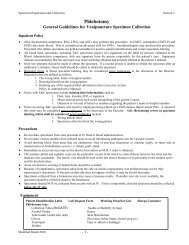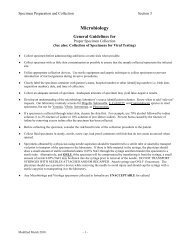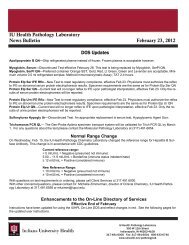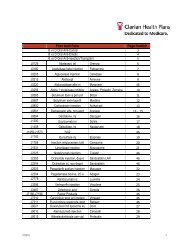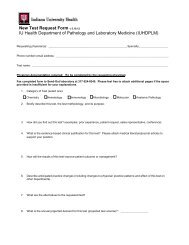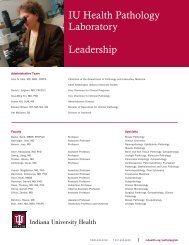Download PDF - IU Health
Download PDF - IU Health
Download PDF - IU Health
You also want an ePaper? Increase the reach of your titles
YUMPU automatically turns print PDFs into web optimized ePapers that Google loves.
Long-time lab employee a leaderin lab automation project3If you want to know about the new chemistry analyzersat Clarian, there is one person to talk to. If youwant to know about the new immunochemistry analyzersabout to roll out at Clarian, there is one personto go to. If you want to know about the new roboticsystem going in at Clarian hospitals and the new labbuilding, there is one person who knows all about it.That person is Pam Vollmer.Vollmer is the chemistry technical coordinator forLaboratory Services at Clarian, and her bosses say shehas been a vital part of the planning and execution ofthe lab automation project.Vollmer started as a medical technologist atIndiana University Hospital in 1976 and has held avariety jobs in the labs at <strong>IU</strong> and Riley in the interveningyears.“Everyone who has ever worked with Pam comesaway with great respect for her abilities in the lab,”says Ken Ryder, MD, director of laboratories forClarian Pathology and Laboratory Medicine. “Whenany of the medical technologists that work in thechemistry lab have a question, they automaticallytake it to Pam. She either knows what to do or willfigure it out; always, never fails.”Vollmer was on the committee that helped determinewhich lab automation system would be best forClarian. She listened to vendor presentations, helpeddevelop spreadsheets to compare the various systemsand even went on site visits to see the potential systemsin action.Pam Vollmer says the lab automation project is themost challenging assignment she’s worked on in hernearly 30-year career at Clarian.Challenging and exciting“This project has been the most challenging andexciting project I have ever worked on,” admitsVollmer. “Over the years, we have heard about therobotics coming into the laboratory. It’s just taken along time to get going. In the past, we have had bitsand pieces of automation roll out, but this is the firstcomplete system.”Vollmer’s role in the project keeps her at work – a lot.“She is here seven days a week except for a rareday off,” says Ryder. “During emergencies, such asCerner downtimes, she stays for the duration of theproblem – sometimes working 30-hour or longershifts. A junior member of our pathology faculty toldme he could not recall ever being in the hospital withoutseeing Pam. I don’t know how she does it.”It’s all about patientsVollmer says it helps to keep the patients in mind.“We don’t see the patient or the end result,”explains Vollmer. “But the thought of the patient isalways there. Especially when we get the samplesfrom Riley, we are aware that we have a limitedamount of a sample and that we have to do whateverwe can to conserve it. Even though we don’t see thepatients, we still know what we are doing is veryimportant for them.”After already spending about 18 months on theproject, Vollmer says the thought of a vacation alsohelps keep her going. She is hoping to take a shortbreak when Phase I of the lab automation projectis complete later this summer.High-speed lab automation helps reduce errors, speed results continued…the test and manually accepts or rejects the results bypushing a button on the computer. Then someonemust take the tube of blood and put it in a refrigerator,where it is saved for a couple of days, in case aphysician wants to “add on” another test of thespecimen or redo a test. Along the way it is touchedby a number of hands.Robotic automationWhen the new lab building is complete and functional,physicians and nurses won’t need to do anythingdifferently, except ensure that the label on the tube iscorrectly applied. The tube still goes in a carrier andinto the pneumatic tube system. But this is where thebig changes begin.The pneumatic tubes, three running each wayfrom each hospital, will carry each specimen to thenew lab building. There, a person will touch thespecimen for the last time. The lab worker will takethe specimen out of the carrier, double-check theplacement of the label, and send it on its way downthe new automated track.Ryder explains the new journey for specimens.“The robot takes it to the centrifuge, if necessary.If that is not needed, it just moves it to the analyzer.If it goes to more than one workstation, the robotopens the tube, takes enough of the specimen outand places the proper amount in daughter tubes,labels the daughter tubes, and takes everything to theinstruments. The instruments run the tests, and thenthe robot takes it and puts it in the refrigerator. Ifanother add-on test or re-test is needed, you just goto your computer and order it. The robot retrievesthe specimen and does the requested work.”Ryder says even though most people refer to itas a “robot,” the automation is really more like aCoca-Cola bottling line.Did you know?In 2004, Clarian labs performed 8.2 millionlab tests. That’s 16 results everyminute of every day, all year long.The labs’ workload has grown 10 percenteach year for the last five years. Andwith the addition of Clarian West, it maygrow at an even faster rate.He says decreasing the number of hands touchingeach specimen decreases the chance that an error willbe made or that the specimen will be lost, becausecomputers will track the specimen at each step ofautomation. But he says the big benefit will be ahuge decrease in turnaround time – the amount oftime it takes from when the specimen reaches the labuntil the results are available by computer.“Right now, it takes somewhere between 60 and90 minutes for the whole process to take place,”says Ryder. “When all the automation is in place,that time should be greatly reduced.”Ryder says lab experts from Clarian spent 18months visiting health care facilities across the countryto see how their automated systems functionedbefore selecting the system Clarian wanted. He saysthe system is so fast that there is no concern aboutfreezing weather disabling the pneumatic tubes. Andwhile he says there is always the remote possibilitythat a carrier could get stuck in a tube, it has neverhappened at the facilities they studied, some ofwhich (like the Mayo Clinic) have used the systemfor decades.Sam Odle, president and CEO of Methodist andIndiana University hospitals, is excited by the newlab facility and automated systems.“One of the most important foundations in ourability to deliver patient care second to none is timelyand accurate clinical lab results,” says Odle. “Ourlaboratory staff has designed a strategy to deliverclinical laboratory results in a manner that is unlikeany other hospital in Indiana. The state-of-the-artlaboratory robotic system will assure accuracy, timelinessand quality laboratory results for Clarianpatients and physicians.”To learn more about Clarian lab automation, contactPam Vollmer at 274-0144 or pvollmer@clarian.org.




